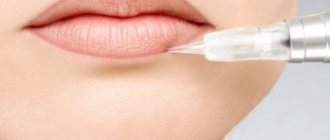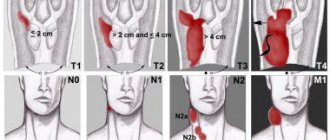Situations in which swelling is not a cause for concern
In many cases, swelling that occurs after tooth extraction is normal and should not cause alarm.
There is no need to worry if:
- The swelling is mild and does not increase over time. If tooth extraction turned out to be traumatic or was carried out against the background of severe inflammation, then slight swelling is allowed to appear, which should go away on its own in a couple of days.
- Body temperature is slightly elevated, but does not increase over time, or is completely within acceptable values. Removing a tooth when it is inflamed can cause a slight increase in temperature, which, if the source of pain has been eliminated, quickly subsides.
- There is no increasing pain. A sign of normality is the presence of slight pain (after all, removal is a surgical procedure during which soft tissues are injured), gradually decreasing over time. If the pain does not go away, or its strength increases, then this indicates either increasing inflammation or the occurrence of any complications.
- The hole left after the operation is closed with a blood clot. Naturally, after the procedure, the hole is filled with rapidly clotting blood. This clot reliably protects the tissue, preventing the development of an inflammatory process.
After removal, the cheek may look swollen for one day - this is a period during which you should not worry. If after 24 hours there is no obvious deterioration and the swelling decreases, there is no need to waste time on a visit to the dentist. But if at least one of the symptoms listed above is present, this indicates the need to make an appointment with a dentist as quickly as possible in order to prevent the situation from worsening.
What is included in the complex of restorative procedures
The rehabilitation course allows you to return to a full life - walking, going to work the next day after surgery of any complexity
The procedures are aimed at improving the patient’s condition - reducing swelling, bruising on the face, and pain. Internal swelling goes away, due to which patients often bite their cheeks or simply cannot eat normally.
Lymphatic drainage
The main effect of lymphatic drainage injections is the normalization of lymph and blood flow in the operated area. The composition of multicomponent preparations includes a complex of nucleotides, peptides, vitamins and microelements. By improving blood circulation and accelerated lymph outflow, swelling is minimized and hematomas are resolved.
We use only original certified drugs:
- D-NUCLEO UNO (Israel) Biostimulator, biological product. Contains a complex of PDRN polynucleotides, which increase collagen production and improve cellular metabolism. In addition to the lymphatic drainage effect, it has a powerful anti-inflammatory effect.
- MesoSculpt C71 (USA) Hypothermal drug, lipo-modifier. Contains a component responsible for the restructuring of fat cells. Activates lymph flow, improves skin condition, tightens facial contours due to restructuring of intracellular metabolism.
The D-NUCLEO UNO ampoule contains 3 mg of the drug, which is enough for the entire lower third of the face. Most often used in global operations:
- multiple and total implantation
- bone grafting and sinus lifting in the area where 3-5 implants are installed
- bilateral sinus lift and osteoplasty
- combined surgery
- revision of the maxillary sinus, removal of foreign bodies, removal of tumors
MesoSculpt C71 contains 1 mg of the drug in a syringe, used for smaller interventions that were performed in one segment:
- removal of 1-2 teeth of varying degrees of complexity in one area
- single or segmental implantation
- unilateral sinus lift or osteoplasty
Both drugs have a similar principle of action, have unique regenerative properties, promote rapid recovery and healing of wounds in the oral cavity by nourishing the surgical area, relieve swelling and pain. The cosmetologist selects the optimal one for each patient depending on the volume of manipulation.
Injection procedures are performed immediately after surgery while the patient is still under sedation. There are no traces left from the injections; the cosmetologist uses a very thin needle to prick the external nasolabial triangle or the surgical site locally. If repeated manipulation is required, an anesthetic gel is first applied for 15 minutes, so the patient does not feel pain.
PRP therapy
PRP therapy (plasmolifting, plasma therapy) is also an injection procedure. Platelet-rich blood plasma is used as a stimulating substance, which triggers regeneration processes.
Platelets release various growth factors for capillaries and fibroblasts, resulting in tissue healing faster. Cells of the immune system are attracted, the local defenses of the body are strengthened, this gives a powerful anti-inflammatory effect. Plasma therapy is also used to accelerate lymph and blood flow, minimize swelling, and lighten bruises.
Plasma concentrate is obtained from the patient's blood. While he is still under sedation, blood is drawn from a vein. The plasma is separated by centrifugation in a test tube. The cosmetologist punctures the surgical area externally; usually 1-2 tubes are enough.
The procedure is suitable after non-global surgical interventions, which usually involve minor swelling:
- simple removal of one or two teeth
- installation of one implant
- fixation of the healing abutment
- gum plastic surgery
Microcurrent therapy
This is a physiotherapy procedure, performed in our Center using the Biolift 8806 Gezatone device (France).
Thanks to the effect of low-frequency microcurrents on all layers of the skin, the functional activity of cells improves, blood circulation increases, lymph flow normalizes, metabolic processes accelerate, and the synthesis of collagen and elastin increases. After microcurrent therapy, swelling and hematomas decrease.
Microcurrents have a stimulating and strengthening effect on muscles, restore facial tone, and relieve muscle tension. A person can open his mouth in a normal state without pain, eat well and talk calmly.
Since the procedure has a versatile effect, it can be used after any surgery associated with swelling and bruising. It helps especially well after long-term operations associated with muscle spasms and disruption of the TMJ due to a long stay in an uncomfortable position with an open mouth.
Microcurrent therapy is painless - an anesthetic gel with hyaluronic acid is first applied. The session lasts 20-30 minutes and feels like a facial massage in a spa.
It can be performed on the day of surgery, but it is better after 2-3 days - it is on these days that the pain worsens. The patient better understands what difficulties he has (muscle spasms, poor mouth opening or hyper-swelling), and the cosmetologist understands which areas need more work.
When you can't do without a doctor's help
If any of the situations listed below arise, you need to go to the dentist, who will take the necessary measures (wash the hole, put in medicine, take measures to release pus, etc.).
So, you can’t do without a trip to the dental clinic if:
- The swelling that appears after removal does not subside, but, on the contrary, grows. In this case, there is no point in continuing to wait, since it is obvious that the situation will not resolve itself. Swelling may indicate inflammation or suppuration. In some cases, swelling can develop to large sizes, affecting the area under the eye.
- There is pain that does not decrease over time. Severe pain for a couple of days is acceptable only with a particularly difficult removal, accompanied by sawing out the bone: in all other situations, the pain should decrease and completely disappear after 1-2 days.
- The temperature rises.
- Feeling unwell does not go away.
- There are difficulties opening the mouth and making swallowing movements.
- There is no blood clot in the hole left after tooth extraction. Perhaps the clot simply fell out or was washed out when rinsing the mouth. If there is no clot, then the risk of inflammation increases, which is accompanied by very severe pain. It is useless to wait patiently for the pain to go away on its own: the dentist, having assessed the situation, will administer the required medicine, which will quickly relieve the discomfort.
Sometimes swelling does not appear immediately, but 3-4 days after surgery. Typically this is due to the fact that:
- the blood clot in the socket has festered;
- inflammation began in the hole.
This condition is called alveolitis. With this inflammatory lesion, self-medication using antibiotics and other medications is pointless. Only a doctor can alleviate the patient’s condition by clearing the hole of small food debris and placing medicine inside.
Sometimes a hematoma may form on the gum. In the first few days after its appearance, it may not cause attacks of pain or lead to swelling of the cheek, however, when obvious signs of suppuration are visible, leading to pain, you should consult a dentist, who will most likely open the hematoma.
Oral care after bone grafting
Proper oral hygiene is important to prevent complications. Caring for your teeth and the operated area should be thorough and gentle.
- Brushing your teeth is recommended after every meal for several days after surgery.
- Use only a soft toothbrush
- During cleansing, do not touch the operated area.
- Active rinsing of the mouth with antiseptics is prohibited; oral baths are allowed
- Treatment of operated areas is carried out with moistened cotton swabs
- The wound surface and sutures should be treated extremely carefully to avoid mechanical damage.
Cleaning the mouth after eating should be thorough but gentle. In the first days after surgery, it is quite easy to cause bleeding or suture dehiscence.
Read more about the rules of care - Oral care
When should swelling occur?
There are situations when the development of noticeable edema is inevitable. They arise:
- After an operation of increased complexity. Removal accompanied by damage to nearby tissues (for example, when it is necessary to saw out bone or incisions in the mucous membrane) leads to the appearance of edema. In some situations (for example, when the eighth tooth is removed), facial asymmetry is likely to occur.
- When removed due to severe inflammation. Then an infection remains in the hole, which can become the main cause of swelling. If the operation is carried out in compliance with all the rules, then the dentist, seeing inflammation, is obliged to thoroughly rinse the wound with an antiseptic solution, and then apply the medicine. Sometimes antibiotics are prescribed. However, even then it cannot be said that the inflammatory process will not begin.
- When cutting the gums on which there is an abscess, the dentist makes an incision to release the pus located in the soft tissues. If there was already a slight swelling during the procedure, it may increase slightly in size, which is normal.
- When contacting people suffering from certain diseases. Quite often, according to the observations of dentists, patients who have high blood pressure complain about swelling of the cheek after tooth extraction, leading to the accumulation of a subcutaneous fat layer on the face. In such people, swelling may well appear even with normal removal, which proceeds without any complications.
Hematomas and swelling after surgery
Surgery is not a regular medical procedure. This is a kind of trauma, with damage to mucous and bone tissues. As a result of the physiological reaction of the body's defense systems, there is an influx of lymphatic fluid, which helps the operated area to regenerate and recover. It manifests itself as internal swelling of the oral mucosa, swelling of facial tissues. Hematomas are possible as a result of damage to blood vessels.
Long-term large-scale operations are complicated by the need to stay with your mouth open for a long time. Muscle spasms and pinching of the maxillary joint are likely. It can be difficult for the patient to adapt - muscle tension is felt, it is difficult to chew and speak. This is a normal, explainable condition; traditionally, rehabilitation lasts 7-14 days, in some cases up to a month.
For patients who want to quickly get rid of postoperative discomfort, our Center offers an accelerated rehabilitation program. A complex of injection and physical procedures reduces swelling, eliminates bruises, reduces pain, and completely eliminates micro-spasms of the muscles of the face and neck.
We
do not use outdated punitive surgical
. We have not used drills, hammers and chisels since 2012. Work with bone tissue is performed using ultrasonic piezo technology with minimal trauma. For patient comfort, all operations are performed in medicated sleep.
Levin Dmitry Valerievich Chief physician and founder of the Doctor Levin center
Despite gentle technologies, tissue injury cannot be avoided in any case. The body's reaction to intervention is an understandable natural process. The “brightness” of the manifestation is individual and depends on the volume of the operation performed and the characteristics of the body. For example, representatives of the fair sex are more prone to swelling than men.
How to get rid of swelling at home
If there is no reason to see a doctor, but you want to get rid of the swelling as soon as possible, you can try the following methods:
- Immediately after removal or surgery, apply a cold compress (water bottle, wet cloth). The application must be repeated throughout the day once every half hour for 5 minutes. ATTENTION! Using a cold compress on the second, third, etc. day is unacceptable.
- Use special decongestant ointments.
- Sleep with your pillow raised high.
- After a few days, cold compresses are replaced with warm ones. A single session of the procedure should not exceed half an hour. Vasodilation and increased blood flow promote faster recovery.
- use corticosteroids. Since this type of drug has many side effects, it is better to consult a doctor before taking it. You should resort to these medications only in cases of extreme necessity, when pain due to swelling interferes with normal daily activities.
- These methods should be used if there are no complications: in other cases, it is recommended to consult a doctor for a detailed examination.
When should you see a doctor outside of your plan?
Postoperative symptoms are most often an explainable physiological reaction. However, under certain circumstances they can turn into signs of dangerous complications. The patient must be able to distinguish pathology from normality.
Among the complications that arise during the rehabilitation period, the first place always remains infection of the wound site and internal structures, for example, the maxillary sinus after sinus lifting. In this situation, the patient notes:
- severe pain;
- worsening swelling;
- redness of the gums;
- the appearance of purulent discharge;
- temperature increase.
Contact a doctor should be immediate . The surgeon treats the oral cavity, sometimes it is necessary to remove sutures and clean the area with bone material. A course of antibiotics and anti-inflammatory drugs will be prescribed.
There is another unpleasant complication - suture dehiscence. In such a situation, you should immediately go to the clinic, where the dentist will apply new surgical sutures. As a rule, no additional action is required, but in rare cases the graft may become dislodged, which requires almost a second surgical intervention.
Complications associated with rejection of the osteoplastic material or poor fixation of the implants require another bone grafting. Such adverse outcomes may be associated with improper implementation of the dentist's recommendations, so it is important to strictly follow them.
Read more here - Complications after sinus lift and bone grafting
Complications of edema and methods of dealing with them
Often, swelling is accompanied by one or more complications from the list below:
- bleeding. A little bleeding is normal. If there is more blood, the wound can be pressed with a gauze pad moistened with an antiseptic (for example, Chlorhexidine). If bleeding does not go away for more than 2 days, you should not delay visiting a doctor;
- numbness. After any dental procedure, the area around the mouth may lose sensation. There is nothing wrong with this if the side effect goes away within 12 hours;
- the occurrence of pain, which is acceptable even after surgery. The main rule is that pain should decrease within a couple of days. In some cases, the pain can be so severe that a person cannot chew food (the condition should last no more than 5 days). To alleviate this condition, you can take painkillers (for example, paracetamol);
- the occurrence of a dry socket after surgery (especially important for smokers). In this case, a blood clot, without which the healing process is impossible, does not form. The condition is often accompanied by a feeling of pain and an unpleasant taste in the mouth. The most effective way to combat it is to wash the wound several times a day, followed by applying an antiseptic bandage.
Types of complications
The most serious problems can appear during the fusion of the implant surface with the jaw bone: re-implantitis, rejection.
Reimplantitis
This is an inflammation of the tissues that are located next to the artificial tooth. The cause of reimplantitis is the entry of pathogenic bacteria into the cavity between the body of the implant and the gum. This happens if the wall of the paranasal sinus is damaged, there are foci of inflammation in the adjacent tooth, there was an error when closing a postoperative wound, or the crown was made inaccurately. But most often the cause of reimplantitis is poor oral hygiene.
The disease is accompanied by increasing pain, bleeding, and swelling. It is very important to treat it as early as possible, or the disease will become chronic. Gradually, the infection will “eat away” the bone, causing the implant to begin to wobble. In this case, it will have to be removed and then the hole should be treated.
Reimplantitis occurs infrequently - in about 1-2% of cases, but it should be taken seriously.
Rejection of an artificial tooth
Bone tissue may not accept a titanium rod. Most often this occurs due to infectious processes, lack of bone tissue, surgical errors, exacerbation of chronic diseases, and smoking after surgery. Very rarely, rejection may be due to an allergy to titanium.
The beginning of the process is accompanied by increased pain in the surgical area and loosening of the implant. In this case, the tooth is removed and a course of vitamins is prescribed to strengthen the bone tissue. After one to two months, the implant can be re-implanted.
The chance of a new tooth being rejected is 1%.
Diseases that occur after tooth extraction and cause swelling
When teeth are removed (in particular, molars, canines and incisors), the following diseases may occur:
- alveolitis, when suppuration of the hole occurs. Accompanied by swelling of the cheeks and cheekbones. The temperature rises, general weakness occurs, and bad breath appears;
- osteomyelitis is a disease in which the jaw bone becomes inflamed (the process is accompanied by the formation of pus). The cheek swells at the site of inflammation, and the pain affects the entire row of teeth. It becomes painful for a person to open his mouth and talk. The disease is accompanied by severe headache and fever; in some cases, blood poisoning is possible (if you do not consult a doctor in time);
- neuritis. The facial nerve is affected, which is accompanied by acute pain. Quite often it occurs when teeth with long roots are removed. With neuritis, the cheek becomes swollen and numb; numbness also affects the palate, larynx and tongue.
Indications for emergency medical care
If, after a day, severe swelling appears at the site of the extracted tooth, but there is no pain in the socket area, this may indicate the development of a cystic or inflammatory process. When rapidly growing swelling of the cheek (lip, gum, tongue) is accompanied by shortness of breath, these are clear signs of an allergic reaction.
Important! An unpleasant putrid odor from the mouth and the taste of pus indicate suppuration in an empty socket.
Constant throbbing, aching pain in the empty socket or “neighboring” lesions in combination with elevated body temperature, general weakness, apathy, nausea and dizziness are symptoms of intoxication of the body. Discomfort, unpleasant sensations (pain) when opening the mouth, moving the head, while eating, a swollen cheek 3-4 days after extraction are classic signs of alveolitis (inflammation of the alveolar ridge).
How to prevent complications?
To avoid swelling and subsequent treatment, it is recommended:
- Keep your head held high for at least 12 hours after surgery (or better yet, 24 hours). To do this, while lying down, you need to place several pillows under your head;
- do not touch the hole with your tongue or fingers;
- do not use warm compresses for 36 hours after surgery;
- do not smoke or drink alcohol for 72 hours after surgery.
Correct behavior after surgery is no less important than the procedure itself: if you adhere to the above rules, the swelling will go away either in the shortest possible time or will not occur at all.
Home methods
You can speed up the subsidence of edema in the absence of other complications using folk remedies. So, 2–5 g of propolis are crushed and diluted in clean warm water. The resulting mass is applied directly to the lesion and left for 10 minutes. Treatment is carried out three times a day until the hematoma (swelling) disappears.
A few grains of potassium permanganate (manganese) are diluted in a glass of water (you should get a light pink liquid). Rinse your mouth with the prepared product 1 time/2 hours during the first 3 days after extraction. So, 2-3 tablespoons of dry crushed chamomile flowers are steamed with boiling water and left to infuse for 1 hour. The medicine is used for therapeutic rinses (the procedure is carried out 2-3 times a day).
Severe rapidly progressing swelling after extraction combined with shortness of breath are sure signs of an allergic reaction
Preventive measures
Since the likelihood of swelling after tooth extraction is quite high, the following recommendations should be followed to minimize the risk of cheek swelling (the same rules apply in cases where swelling has already formed and needs to be removed as soon as possible):
- use oral baths (the salt liquid is only kept in the mouth without rinsing, since otherwise infection of the hole may occur);
- use anesthetics to relieve pain. As a rule, these are Ketanov, Ibuprofen and other similar drugs that reduce the inflammatory process and relieve pain. The most important thing is to follow the dosage indicated in the instructions;
- follow the diet. If an operation has been performed, then on the first day you should not eat hard or hot food, as it can cause injury to the already damaged gum. During the week after surgery, the basis of the diet should be soft and non-spicy foods. Until the swelling goes away, it is better to chew on the other side of the mouth, doing it slowly;
- Avoid taking hot baths, as this may cause bleeding from the socket;
- When brushing your teeth, skip the operated area until the swelling goes away.
- On average, swelling subsides within 2-3 days from the date of surgery: if this does not happen, you will have to contact the dentist again for an examination and additional research if necessary.
Causes of the problem
Hematoma after wisdom tooth removal is a consequence:
- development of the inflammatory process;
- mechanical damage to soft tissues during surgery;
- complex extraction requiring retination or dystopia of the corresponding unit;
- removal of an abscess (ulcer on the gum);
- individual characteristics of the patient’s body (for example, a bruise on the cheek or even under the eye after tooth extraction may appear in a hypertensive patient, a diabetic, or a patient with weak blood vessels).









